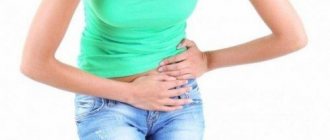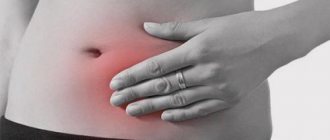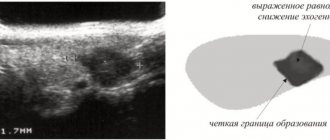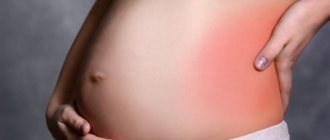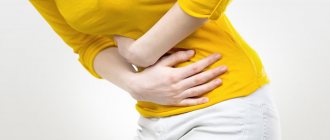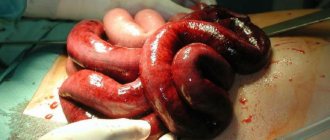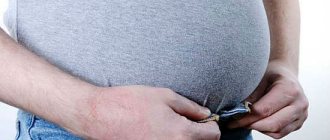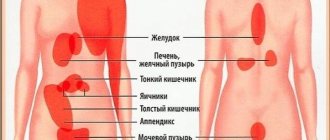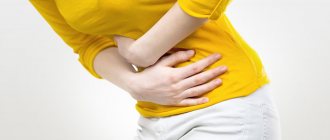Pain during pregnancy
During the period of bearing a child, the female body is more vulnerable and physiologically weakened.
When coughing, pain in the lower abdomen may occur due to hypertonicity of the uterus, or against the background of increased venous pressure. Any pain in pregnant women requires contacting a medical facility in order to avoid complications and the threat of miscarriage. During the second and third trimester of pregnancy, the uterus increases in size. As a result of pressure on the organs and muscle tissue of the abdominal cavity, blood circulation worsens, swelling of the legs and pain appear. Cough provokes sharp muscle tension. Hypertonicity of the uterus with increased load on the blood vessels creates excess pressure in the organs, accompanied by pain.
Pain when coughing during pregnancy is often a natural phenomenon due to overexertion. It is important to remember that prolonged conditions of increased uterine tone can lead to placental abruption.
Particular attention should be paid to the choice of drugs and physiotherapeutic procedures. Most medications are prohibited for use during pregnancy. Only a doctor can prescribe treatment, based on individual indications and characteristics of the body.
Abdominal muscles
The abdominal muscles are a group of muscles located in the abdominal cavity and provide protection to the vital organs located in it.
Abdominal muscle structure
Among the abdominal muscle groups are:
- The rectus abdominis muscle is attached to the xiphoid process of the sternum, the cartilages of the V-VII ribs and to the pubic bone. This is a long muscle that belongs to the anterior wall of the abdominal cavity. The muscle fibers of the rectus abdominis muscle are interrupted by several transverse tendon bridges, which contribute to the formation of abdominal “cubes”;
- Transverse abdominis muscle, attached to the lateral third of the inguinal ligament and the iliac crest;
- The internal oblique muscle of the abdomen, located quite deep and attached to the iliac crest and cartilages of the lower ribs;
- The external oblique muscle of the abdomen, located directly under the skin and attached to the iliac crest, pubic symphysis and the outer surface of the V-XII ribs.
The linea alba is a tendinous band connecting the rectus abdominis muscles. It begins with the xiphoid process of the sternum and ends with the pubic symphysis. The white line in its upper part is quite wide and at the level of the navel ranges from 2 to 2.5 cm. Below the umbilical region it narrows and thickens in the anteroposterior direction.
The umbilical ring, consisting of scar tissue, is located almost in the middle of the linea alba and connects to the skin of the navel.
The light color of the white line of the abdomen is primarily due to the lack of blood vessels, which is used when it is necessary to perform abdominal operations, for example, a cesarean section.
Abdominal muscle function
The abdominal muscles hold the organs located in the abdominal cavity. By narrowing the abdominal cavity and forming the so-called abdominal muscles, the abdominal muscles put pressure on the internal organs that are contained in it. This manifests itself during coughing, vomiting, urination, defecation, and also during childbirth. In addition to this group of muscles, the diaphragm takes part in protecting the abdominal organs.
The abdominal muscles also participate in breathing movements, pulling the ribs downwards, which facilitates exhalation.
Digestive organs
Among diseases of the digestive system there are many pathologies that provoke pain. It may get worse from coughing, or may not respond to it at all. Among them are the following:
- Hyperacid gastritis, in which the left side hurts in the lower abdomen or closer to the epigastric region.
- Gastroesophageal reflux disease, characterized by heartburn, belching, dry cough and pain in the lower abdomen on the left or in the epigastrium. Here the question arises, why does the stomach hurt when coughing and whether such a phenomenon could exist. To get an adequate answer, you need to carefully understand the pathogenetic mechanism of this disease.
- Acute appendicitis. This is the first thing a doctor should think about if there is pain in the right side of the lower abdomen.
Associated symptoms
Additional signs of the disease will help to accurately establish the cause of this clinical picture:
- ARI or ARVI, in addition to cough, is accompanied by fever and sore throat;
- attacks of nausea, frequent belching and vomiting develop with ulcers, gastritis;
- The desire to empty the stomach, fever and diarrhea help identify rotavirus.
An experienced doctor will take into account all the patient’s complaints and conduct an examination to identify the cause of the pathology.
Causes
To determine the cause of the problem, it is important to remember whether the pain or coughing attacks appeared first. If initially there were unpleasant sensations in the abdominal area, then most likely there is no connection between the symptoms. But when discomfort is noted afterwards, the cause needs to be established.
Stomach diseases and symptoms
One of the frequent provocateurs of such a clinical picture is gastrointestinal pathology. Among the main problems that lead to pain are:
- gastritis;
- ulcerative formation.
- Pain in the stomach and joints
Periodic development of stomach discomfort is characteristic, especially after eating. Accompanied by increased acidity of the enzyme, gastroesophageal reflux, aggravated by coughing and causing pain in the inflamed tissues, which is localized behind the ribs, in the stomach area. At the same time, the mucous membranes of the trachea and larynx are irritated, which causes a sore throat.
An experienced doctor will always distinguish a gastrointestinal problem from a cold that provokes a cough. With pathologies characteristic of the digestive tract, there are no symptoms familiar to acute respiratory infections, such as a runny nose or fever.
Abdominal muscle strain
It is often painful for a patient to cough as a result of a tear in the muscle tissue located in the abdominal area. This symptom is especially common among women, whose muscles are less developed than men.
In the case of a severe cough, the abdominal muscles are subjected to physical activity comparable to going to the gym. But if during sports activities it is possible to regulate the number of approaches and, by reducing the number of exercises, prevent the development of symptoms, this cannot be done when coughing.
As a result, muscle tissue is overstrained. You can reduce painful manifestations by tilting your body forward during the next attack. In this case, there is less effect on the abdominal muscles and the clinical picture weakens.
This is a natural cause that does not require drug treatment. After the cough disappears, the discomfort in the stomach stops.
Inflammation of the appendages leads to sharp and severe pain in the lower abdomen in the fair sex.
The disease itself provokes discomfort in the pelvic area, and if there is a cough, the situation gets worse. As a rule, unpleasant sensations are present for a long time.
Sometimes female pathologies do not give characteristic signs, for example, cystitis or ovarian cysts. But the presence of a cough helps identify the problem, as it provokes abdominal pain. Sharp and strong sensations often indicate a rupture of a cystic formation, which requires urgent surgical attention.
Rotavirus infection
A type of influenza that occurs with a clinical picture reminiscent of the symptoms of pharyngitis in combination with pain in the intestinal area and diarrhea.
In this case, abdominal pain when coughing is often observed in children. If the sign appears on the right and below, it means that the ascending portion of the organ has become inflamed. When the left side suffers from coughing, treatment of the descending colon is necessary.
- Causes and treatment of joint pain after removal of the uterus and appendages
Borreliosis
An infection caused by ticks. If therapy is not started in a timely manner, the risk of tragedy is high.
Clinical picture:
- feverish condition;
- spasms in the larynx.
The cough is pronounced, which leads to intense pain in the abdominal area.
Menstruation
In this case, sore throat causes an increase in the already present symptom. The pressure on the pelvic area increases, which is why the characteristic clinical picture appears. A cold provokes spasms of the uterine muscles.
The pain in the lower abdomen is especially pronounced when coughing, if there is no secretion of sputum from the respiratory tract. Pain can occur on the left or right, and can be noted on both sides.
Helminthiasis
The presence of worms leads to the accumulation of toxic substances. The body is literally poisoned, which often results in an allergic reaction. One of the manifestations of this condition is coughing. In this case, abdominal pain can develop both against the background of the symptom and independently of it.
Pain during pregnancy
While carrying a baby, the mother's body weakens. As a result, a cold cough leads to an increase in the tone of the uterus. Long-term pathology provokes placental abruption. The risks increase if hypertension is present.
In the 2nd and 3rd trimester, the organ grows and gradually compresses the vessels, which causes pain due to insufficient blood supply to the abdominal cavity. A cough provokes muscle tension, pain in the lower abdomen on the right or left - it depends on the suffering organ.
Treatment of an unpleasant symptom is difficult, since most medications are prohibited. But uterine hypertonicity can lead to fetal loss. Therefore, pregnant women must consult a doctor if they have abdominal pain as a result of coughing.
- Why does the jaw hurt on one side when chewing near the ear: what does pain on the right and left mean, how to treat it?
About cough
The causes of cough and inflammation of the mucous membranes are associated with many factors.
Coughing occurs in absolutely every person and is considered a protective reaction of the body in response to foreign agents entering through the respiratory tract. So a cough occurs when even the smallest particles of dust enter the mouth, nose or larynx, irritating the mucous membrane of the nasopharynx. Thanks to coughing, the airways are cleared and freed from pathogenic agents.
However, a cough can occur not only due to short-term irritation of the mucous membrane of the nasopharynx by small particles, but also due to inflammation of that same mucous membrane. Then the cough acquires a persistent, sometimes painful tone, bothers the patient day and night, and goes away only after applying specific and effective therapy. It is worth remembering that a cough is a signal that the infection has gone down the respiratory tract and has spread not only to the larynx and pharynx, but also to the trachea, bronchi, and in severe cases, to the lungs. That is why, due to the seriousness of the pathological process and the danger of severe complications, if a cough appears, especially prolonged and painful, it is necessary to consult a doctor to obtain information about the state of your health and qualified recommendations for eliminating the disease.
Help at home
First of all, it is necessary to eliminate the cough - then the pain will disappear or weaken. Effective methods:
- inhalation to accelerate the removal of sputum: this method is always used if a child has a cough; when treating adults, it is used selectively;
- daily water consumption increases, which helps thin sputum;
- recipes based on honey, radish, and onions help eliminate signs of an infectious disease;
- direct effect on the tonsils: rinsing, anti-inflammatory drugs (tablets, sprays);
- increasing the level of air humidity in the room, while reducing the intensity of throat irritation.
If abdominal pain appears before the cough begins, you should consult a doctor and undergo an examination
Manual therapy
Pain in the right side when coughing can be cured by a chiropractor, but only in cases where the pain syndrome is caused by diseases of the spine - intercostal neuralgia, thoracic osteochondrosis, injuries and bruises. An experienced doctor uses the palpation method to assess the condition of a person’s skin and muscles. Manual therapy sessions are carried out once every four days. The procedures help eliminate pain in the right side by maintaining muscle tone. After the first sessions, the patient may feel unpleasant pain symptoms in the muscles and weakness in the body. For preventive purposes, you can resort to manual therapy 2-3 times a year.
Before the course of treatment, you must undergo the following examinations:
- radiography;
- MRI;
- general analysis of blood, urine and lymph;
- computed tomography;
Manual therapy in combination with drug treatment will help eliminate pain in the right side when coughing, which is caused by orthopedic defects and spinal deformity.
What else is used?
To get rid of abdominal pain, you can lie on your back, put a pillow under your head and lie down, it is useful to sleep. The following methods are also used:
- Relax. The basis of this principle is relaxation of the body. First, you need to slowly inhale and exhale with a 3-second break. You should breathe with your stomach and diaphragm. Facial massage is useful because it relaxes the whole body.
- You need to reach up. The exercise is done for 3-5 seconds.
- You should take a cat pose. The method is effective, but is only suitable for home use. When exercising, you need to raise your head high and breathe evenly.
- Walk. It is advisable to go outside. With the help of a leisurely walk, a natural massage of the legs and abdomen occurs. It's better to walk in parks.
- Valerian and motherwort are suitable. Moreover, it is not necessary to use tablets or custard leaves. Alcohol tinctures are prohibited.
- Soothing music, sounds of the forest, and favorite movies can also help relieve stress.
To prevent pain in the future, it is necessary to perform prevention. To do this, you need to walk outside every day, and otherwise reduce the load. These measures are also great for pregnant women.
Treatment tips
A set of procedures for patients whose ribs hurt when coughing is prescribed only by a doctor after a detailed examination of the patient. It is highly undesirable to deal with such symptoms on your own. If a person has been diagnosed with an acute inflammatory disease of the respiratory organs, he will be prescribed the necessary therapy.
Therapeutic therapy is prescribed individually to each patient, depending on the factors that caused the pain in the side. The main task will be to get rid of the cough, which causes pain. To do this, you need to undergo a course of drug therapy and maintain the effect with folk remedies. You can protect yourself from coughing with the help of preventive measures. It is recommended to give up bad habits, especially smoking. If you often get colds, you can take vitamins during the season of outbreaks of viral infections. It is necessary to dress according to the weather, and keep your feet warm. Avoid situations that could cause injury to your chest area.
What does dull, pulling, pinpoint or cutting pain in the abdomen indicate?
The presence of pain in any part of the body indicates the progression of the disease. The nature of the pain syndrome is classified into pathological and physiological (the case of pregnancy).
Nagging painful sensations can be a temporary ailment or appear suddenly with such intensity that the patient cannot cope with them (there may be a serious threat to health).
Painful sensations indicate:
- gastrointestinal disorders;
- kidney problems (pain radiates to the lumbar region);
- inflammation of the urinary and reproductive systems.
Any disorder of the gastrointestinal tract is a consequence of ongoing diseases; their carrier often has no idea about the presence of problems in the body.
Reasons why the normal functioning of the gastrointestinal tract is disrupted:
- Peptic ulcer: the intensity of pain varies - from moderately weak to unbearably strong. In case of acute cutting pain, urgent medical intervention is carried out, because probably the release of acidic stomach contents into the abdominal cavity.
- Inflammation of the mucous membrane (gastritis): manifests itself in dull, aching pain, heartburn (often after a person has eaten).
- Pancreatitis: pain begins in the upper abdomen, tormenting for several days, while eating, the discomfort intensifies (bloating is felt, the temperature may rise).
- Inflammation of the gallbladder: pain in the right hypochondrium, often radiating to the arm, chest and neck on the right side.
Diseases reveal themselves by tingling, nausea, vomiting, and fever.
Rare sources:
- Stomach polyps: diagnosis is difficult; the medical history consists of a dull aching pain on palpation, bleeding, nausea, and vomiting.
- Cancer: characterized by a constant, mild aching feeling in the stomach.
- Stress: great physical and emotional stress can cause disturbances in the functioning of the gastrointestinal tract, causing a feeling of pain in it (stool upset and vomiting may occur).
- Allergy: when an allergen enters the body, an aching feeling appears that does not have a clear localization.
If the pain is physiological in nature, i.e. a woman is carrying a child, this is a natural phenomenon: the growing uterus puts pressure on nearby organs, resulting in a feeling of discomfort.
